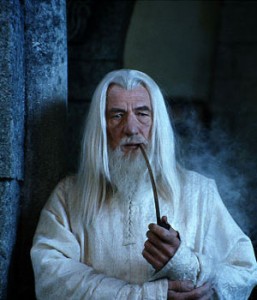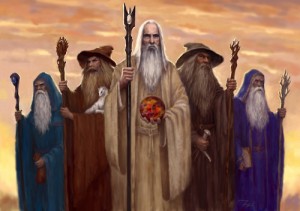For a perfect example of Tolkien’s wildly creative genius, one needs to look no further than the Istari—his Wizards.
What were the Istari exactly? Quite simply they were angelic creatures whose souls had been deposited into corporeal vessels—bodies resembling old men. Their memories of their lives in the Blessed Realm (from whence they had come) were virtually wiped from their minds, leaving only a dim recollection of their former divine selves and life amongst the demigods called the Valar.
Even though the Istari were created as old men, they aged very slowly. When Gandalf showed up at Bilbo’s door at the start of The Hobbit, he’d been living in Middle-earth for two thousand years. (No wonder he needed that staff!) The Istari were no “conjurors of cheap tricks,” however, as Gandalf said to Bilbo in a moment of anger after Bilbo’s “eleventy-first” birthday party. They had been chosen by the Valar to come and serve the Free Peoples Middle-earth in their fight against the growing power of Sauron—the wicked servant of an even wickeder master named Morgoth (himself a fallen Vala).
The Istari were forbidden to reveal their true powers and were supposed to merely guide Men, Dwarves and Elves with good advice (and some occasional magic). And all of the Istari had been given free will to act in the ways they each thought best to achieve their mutual goal of destroying the creator of the Ring of Doom.
There were only five of these Istari in the history of Middle-earth: Gandalf the Grey, Saruman the White, Radagast the Brown and two others who are briefly mentioned but not named in The Lord of the Rings. (These two “missing” Wizards names were revealed in the posthumously published Unfinished Tales.)
Each of the Wizards reacted to their new home quite differently. Radagast became enamored of the flora and fauna of Middle-earth and eventually forgot his quest. Saruman became intoxicated by power and headed down the same crooked path as Sauron, and was eventually ensnared by the Dark Lord himself. Only Gandalf remained true to the distant memory of the Valar “a vision from afar off,” and died fighting one of Morgoth’s ancient creations—the Balrog—in the Mines of Moria. And then he was resurrected…brought back to life by the Valar and given another body (the corporeal form of Gandalf the White).
This is all visionary stuff. Spiritual beings placed into bodies manufactured by demigods, like avatars in a videogame. A main character killed off and reincarnated back into the tale—something I don’t think had ever been done in the history of literature until Tolkien’s epic. The concept of the Istari is especially inspired when one keeps in mind Tolkien conceived all of this in the middle part of the 20th century—nearly three quarters of a century ago.
In my opinion, Tolkien could have penned an entire book based on Gandalf and Saruman alone. Wizards are fascinating. Peter Jackson & Co. must have felt the same, because they’ve written both Saruman and Radagast into The Hobbit Trilogy (you can see Radagast in the film trailer being pulled in a sleigh by a gigantic bunny rabbit—a vision of inspired lunacy).
The tales of the two missing Istari would have made a great story as well. The only time a reference is made to these other two Wizards is in The Two Towers (in the chapter “The Voice of Saruman”) when, after the Ents have destroyed Isengard and trapped Saruman, the corrupted Wizard rails at Gandalf, accusing him of wanting to take control of all of Middle-earth, including seizing hold of “the rods of the Five Wizards.” Three of these “Five” Wizards are Radagast, Gandalf and Saruman himself. The other two Istari are never mentioned again, not even in the Appendices.
After Tolkien died, however, his son Christopher put together a collection of his father’s writings called Unfinished Tales that revealed selections of J.R.R. Tolkien’s notes and stories about Middle-earth that had never been published before. In the chapter concerning the Istari we learn more about these two missing Wizards. They were certainly called the “Blue Wizards” and they may have even been named Alatar and Pallando (a great subject for starting a heated debate between Tolkien geeks).
Soon after the two Blue Wizards arrived in Middle-earth they passed into the East on a mission alongside Saruman never to return. The “East” here means the distant lands of Harad (and Far Harad)—the realms populated by evil Men under the thrall of Sauron. (These are the same Men who join Sauron’s forces and attack Minas Tirith in The Return of the King.)
Did Alatar and Pallando go on a mission to study the ways of the Enemy? Were they ensnared by Sauron and become his servants, intending to do good but falling into evil? Or were they betrayed by their travelling companion Saruman out of jealousy or fear, thus starting Saruman’s downward spiral into villainy? We will never know, because Tolkien didn’t write their tale. It’s interesting to speculate, however. Perhaps Saruman killed them and absorbed their power. Or maybe they were captured and destroyed by The Dark Lord, their sprits sent flying back to the Blessed Realm. Whatever the case, by the time the events of The Lord of the Rings begin, the missing Istari are nothing more than a passing reference in Tolkien’s vast sub-creation.
Fortunately for Middle-earth there was Gandalf, the wisest Istari who never gave up hope, who always returned at the turn of the tide, the divine being sent in “human” form to help defeat Sauron and who—once his mission was accomplished—happily boarded a ship for the Blessed Realm. Before departing Middle-earth for his true home, he imparted sage advice to Merry, Sam and Pippin: “Go in peace! I will not say: do not weep: for not all tears are an evil.” This Wizard would be missed.


